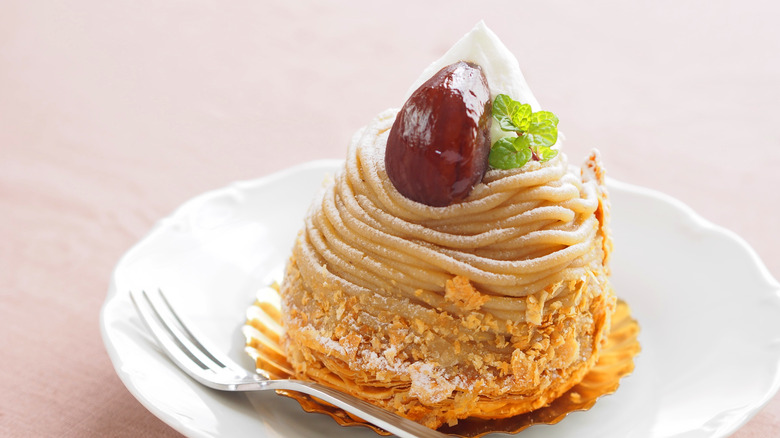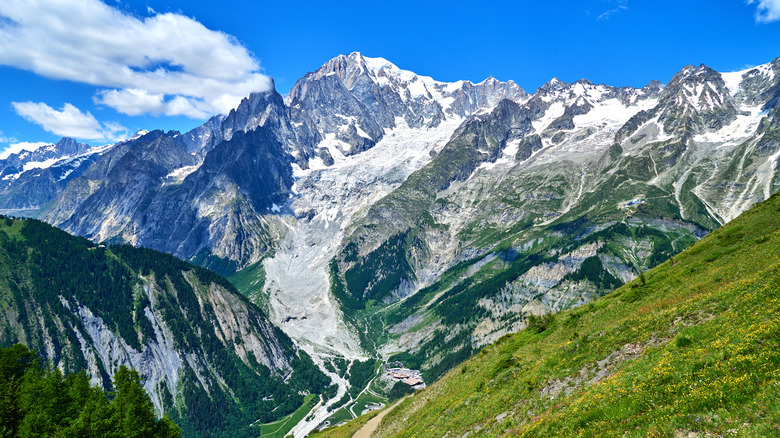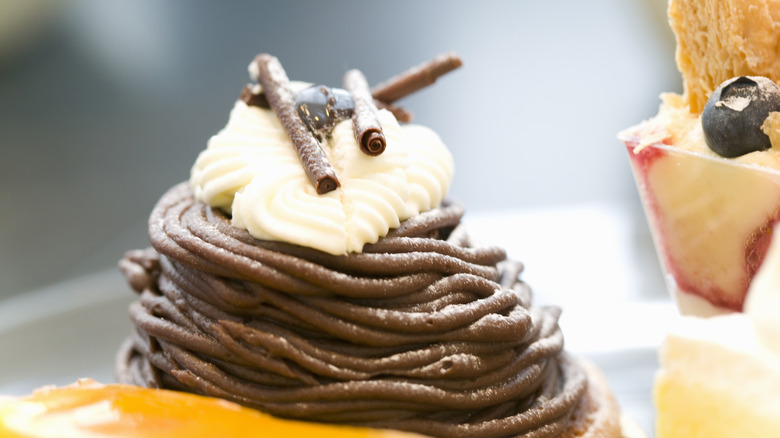What Exactly Is A Mont Blanc Dessert And What Goes Into It?
The history of French cuisine is filled with pastries both sweet and savory. Though croissants are actually Austrian, there are plenty of pastries that are uniquely French: macarons, profiteroles, brioche, eclairs, pain au chocolat, the list goes on. In many ways, the history of France is inextricable from the history of pastries, especially considering how far back it goes: the puff pastry was originally created in 1540. Sitting squarely within this crucible of pastry fire is the Mont Blanc, whose name literally translates to "White Mountain" — appropriate, since it's modeled on a real place of the same name.
A mix of chestnuts pureed and then served in a distinctive vermicelli shape atop a meringue cookie with whipped cream in the center, something like the Mont Blanc has been a staple on the menus of Parisian bakeries for over a century — and which gets its origin from one of France's most prominent cultural symbols. How it's made and what goes into it is interesting enough, but this is a dessert with a story to tell.
Mont Blanc is named after a literal mountain
Chestnut isn't a super common flavor in America, but it certainly has a rich history in French cooking. Chestnut purees have been around for centuries, but the first time you see a reference to a "Mont Blanc" is in an ad from 1847 that does feature cream – but this version doesn't talk about vermicelli. But it was routinely referred to as a dessert by the 1880s, meaning we can infer that it must've been around for at least some amount of time before that. So at the very least, this specific dessert dates back 140 years.
But where did it get its name? It turns out, that's even simpler: from the actual Mont Blanc. Mont Blanc, the real "White Mountain," towers over the French-Italian border, and is one of the most important cultural symbols of France. It's such a striking landmark that Chamonix, a town located at its base, was the site of the very first Winter Olympics. It makes sense Parisians would name a food after such an important cultural landmark, particularly one they formed to look like the mountain itself. The ingredients themselves show this: The cookie is the base, the chestnut vermicelli serves as the mountain, and the whipped cream is its snow-capped peak.
Mont Blancs are kind of hard to make
The process of making a Mont Blanc, meanwhile, is pretty complicated for a dessert that only has three basic components. Making a meringue is probably the trickiest part, as there's a whole bevy of ways that process can go wrong. Beating egg whites with salt, adding cream of tartar, carefully folding in sugar, whipping them to just the right consistency, then piping the resulting mixture into cookie shapes — there are a lot of steps in there where people can make a mistake, and that's just the first part of the Mont Blanc-making process.
Chestnuts aren't really any easier to work with; you can't just throw them in a blender and be done with it. You have to bake the things until the skin comes off, boil them until they're soft, blend them, then add syrup to the resulting mixture to get it to a puree consistency. Only then can you put it in a piping bag and carefully make vermicelli noodles out of it atop the meringue. At least there's the fact that compared to the first two components, making whipped cream is a breeze.
The end result may be something that's too complicated for bakers to make at home regularly — and unlike in France, there isn't a bakery on every corner in America. In Paris, though, bakeries rule the day, and Mont Blancs are available in pretty much any self-respecting patisserie.


